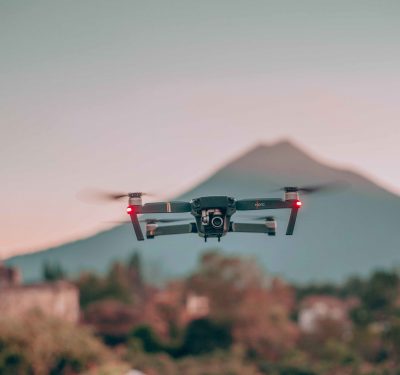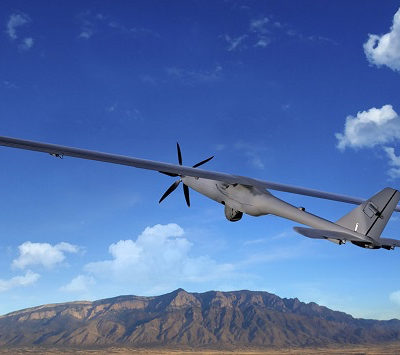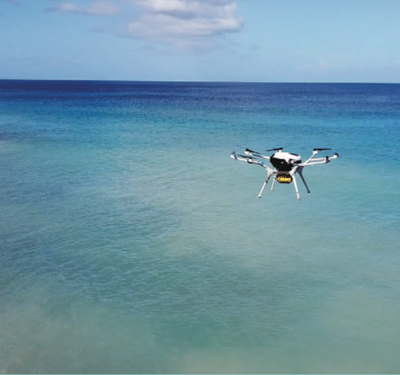As more sophisticated drones become common on the battlefield, deployed for missions ranging from surveillance to targeting, warfighters must have access to low-cost tools that can identify, track and defeat them.

Today’s warfighters are always being watched.
Drones are following their every move, reporting back what they find to the adversary via high-res imagery and video—often without anyone ever knowing they were there.
While the drone threat on the battlefield isn’t new, it has evolved significantly over the last few years, with conflicts in Ukraine and Israel driving the shift. UAS are being deployed in mass, and have the ability to fly at higher altitudes for longer periods while carrying more dangerous payloads. These systems have multiple mission capabilities, from ISR that provides target information for artillery missions to dropping explosives with kinetic effects.
And this is just the beginning. The threat UAS represent will continue to grow, making it critical to develop and deploy counter UAS (CUAS) technologies that can identify, track and mitigate these systems.
“There is no surprise anymore; the adversary can see you wherever you are,” said Lt. Col. Moseph Sauda, director of the Joint C-sUAS University (JCU) in Fort Sill, Oklahoma, where students are trained to counter drone threats. “There’s no such thing as air superiority when everyone has drones flying around.”
One of the keys to defeating hostile UAS is to plan for attacks. Soldiers must use everything in their environment to make drone threats detectable, which Sauda said is the most difficult yet most critical piece of CUAS. If you can’t detect them, you can’t track and defeat them.
Developing CUAS technology has become a DOD focus, said Richard Giordano, director of programs for the Defense Strategies Institute, which is hosting a CUAS & Integrated Protection summit November 5-6 in Huntsville, Alabama. There’s a lot of investment through programs like Replicator, but some would argue there’s not enough on the CUAS side.
“There is a disparity in the cost to defeat versus the cost to create,” Sauda said. “The amount of research development and engineering ingenuity it takes to create a better UAS is significantly cheaper compared to the R&D, training and everything else it takes to defeat it. In some cases, spending is a 1,000 to 1 ratio.”
The threat is evolving as a “never ending combination of a leapfrog and cat and mouse game,” said Jeffrey Starr, chief marketing officer for D-Fend Solutions. The defense sector must stay current on the latest drone advancements to effectively counter those technologies, meaning CUAS tools must be flexible and software driven. It’s not just about today’s threat, but what’s coming tomorrow.
Unlike the commercial side, constantly updating tools isn’t something the DOD and its vendors are used to, but that will need to shift, Kinard Technologies CEO Dane Pigott said. As drone use continues to proliferate, the military will need to rethink how operations are conducted and how they approach security.
“Counter drone security will need to be integrated deep into all operations, just like regular security is now,” he said. “That means equipping large parts of forces with training, equipment and tactics to effect a counter UAS mission.”

FLEXIBLE PROTECTION
Until recently, CUAS focused on protecting fixed assets with permanent installations that employ high-power microwaves, lasers or missile systems. While these are still critical areas to safeguard, now there’s a need to protect mobile soldiers.
“Drones were once thought of as a threat to hit a base,” Pigott said, “now they’re thought of as a threat to hit anyone.”
Flexibility has become paramount. CUAS must offer various configurations and deployments, Starr said. Backpack CUAS tools, for example, give soldiers bubbles of protection, while solutions that include various sensors can be placed on vehicles to safeguard convoys.
“In a vehicle, you could have radar, a camera or some EO/IR capability, and another vehicle may use that first vehicle as a complementary solution to launch a laser guided munition to take down a UAV,” said Greg Fortier, SAIC’s senior VP for the Army Business Group. “The laser can come from the vehicle itself or a support helicopter or ground element to prosecute the target as quickly as possible, all the while the common thread is a single pane of glass command and control software.”

DETECTING THE THREAT
To protect assets and soldiers, you must first detect the threat. There are many proven technologies that do that, but all have their advantages and disadvantages, Starr said.
One of the most commonly used, Starr said, is radar. Radar is great at detecting objects, but it can’t necessarily identify what the object is, often giving false positives. It might have trouble distinguishing between, say, a flock of birds and a swarm of drones.
Radar companies are providing solutions to address that challenge. Echodyne’s metamaterials electronically scanned array (MESA) radar, for example, generates real-time tracks with precise location details. Using additional beams, it can gather more data about a threat, VP of Marketing Leo McCloskey said, including size, range, elevation and speed. When it detects something that’s clearly a drone, it’s classified.
“The radar figures out if the object is a bird or something you should be paying attention to, then drops it into the tracker que, meaning it will revisit that object at ten times per second,” he said. “From a system perspective, when you have that high rate of data, you lock optics on the intruder and the optics follows it smoothly. That matters for effectors, because it has to stay trained on the object for successful engagement.”
Raytheon’s KuRFS radar uses algorithms to weed out clutter so forces can determine if a UAS is coming at them, and then start the process of target identification and defeat if required, said William Darne, director, C-UAS & Short Range Ground Based Air Defense Requirements, Capabilities, and Solutions, Raytheon Land & Air Defense Systems. KuRFS is part of the U.S. Army’s Low, Slow, Small UAS Integrated Defeat System (LIDS), which combines radar with the Coyote effector and other tools.
“It starts with the sensor,” Darne said. “This isn’t a single bullet solution; it’s integrated, it’s layered, it’s tiered. There’s no stand alone system. We have to be integrated with other systems as part of a layered defense.”
Optical and thermal based cameras are another proven technology for an integrated drone defense, Starr said, but they need a clear line of sight to detect a threat. They’re also impacted by weather and the environment.
Optical sensors can range from a $2,000 security camera you might find in a parking lot to a half a million dollar infrared camera, said Mary-Lou Smulders, chief marketing officer and head of government affairs at Dedrone. Acoustic methods make it possible to detect drones based on audio signatures, while radio frequency (RF) listens for comms between the remote and the drone.
Another solution, RF cyber, can help overcome the false positives that might come from a radar, Starr said. It doesn’t depend on line of sight or sound and can provide accurate, location based identification and tracking in real time, continuously scanning and detecting unique communication signals.
The technologies deployed depends on the use case, Smulders said, and the level of the threat.
“It’s like when you build a house,” she said. “You put locks on the doors, but if you’re more worried about your surroundings, maybe you add a fence, and then motion sensors and camera. It’s that kind of decision making process. How high is the risk, and what kind of drone are we concerned about in this environment.”

DEFEAT OR DESTROY
Once a drone is detected, it then must be tracked and mitigated. There are two main types of mitigation methods: kinetic and non-kinetic.
The kinetic approach destroys drones with a physical attack, like shooting a missile or bullet at it, Giordano said. Lasers and high-powered microwaves also can bring down a hostile drone. Non-kinetic methods, on the other hand, take control of the drone and can be anything from electronic warfare (EW) jamming to throwing a net over the drone.
Because of the cost per shot of kinetic attacks, the DOD is focused on developing inexpensive non-kinetic methods, Sauda said.
“Electronic attacks are very effective, but we’re talking defeat versus destruction. If you want to destroy the drone, EW probably won’t get that done,” Sauda said. “These aircraft are flying lower and they’re flying faster, so to defeat that you’re going to have to spend more money and effort. There’s a lot of research being done, but on the kinetic side the goal is to build cheaper things to destroy these systems.”
Magazine depth is another consideration, Sauda said, with small munition rounds more economical to produce on an assembly line than rockets and missiles, bringing down the cost of kinetic attacks.
There’s also the risk of collateral damage with kinetic options, Starr said. If you fire a missile, it has to land somewhere.
On the non-kinetic side, jamming is an effective option, Starr said. But, you don’t know exactly what will happen to the drone. It could default to its fail safe instructions, go back to its take off position or go to the ground.
Jamming impacts more than just the drone that’s being targeted, Starr said. It could disrupt friendly drones or communications, for example. And jamming is only temporary, so when it’s over, the enemy drone pilot can regain control and “you’re back to where you started.”
RF cyber takes control of the drone and lands it safely without disrupting comms or risking collateral damage, Starr said. It can tell you the drone’s take off position, what type of drone it is, and if it’s friendly or hostile. Soldiers can send it back to where it came from or land it to gather intelligence.
Of course, there are times when a drone threat must be destroyed. Kinard’s CAST, a modular, AI enhanced, networked system that converts analog weapons into digital smart weapons, creates accurate targeting data of where the threat UAS is, Pigott said, and shares that in real time across the network. CAST then calculates the best spot for the soldier to point the rifle and pull the trigger for a high kill probability. The system solves “targeting and cognitive problems,” so forces can just point the weapon and shoot.

IT TAKES A LAYERED APPROACH
CUAS systems are complex, Fortier said. On the identification side, it’s about interlocking a layer of defense and leveraging the latest technology so warfighters can identify a hostile drone, track it and then choose the best mitigation method, whether kinetic or non-kinetic. Through SAIC’s platform, multiple technologies are integrated into successful systems and are “controlled off a single pane of glass.”
The key is that tiered multi layered approach—for both detection and mitigation. These technologies aren’t competing against each other; they need to be able to share knowledge and play their part, Starr said.
“In defense, it’s all sensors on board, all effectors on board,” McCloskey said. “The development we’re seeing most is the command and control software, the C2. That’s the glue that holds everything together and makes it all work.”
HOW THE THREAT HAS EVOLVED
Today, drones are more readily available, both on the friendly side and on the adversary side, Fortier said. They’re a low cost tool that can be modified quickly and “adapted at the speed of relevance.” They’re also expendable. If they’re taken out or lost, they can be quickly and economically replaced.
UAS have seen major advancements in recent years, including longer endurance, Sauda said. Not that long ago, hobbyist drones that could fly for 10 to 20 minutes were the norm on the battlefield. That has gone up exponentially over the last four years. Then there’s altitude. Drones can now fly higher and have been hardened against the elements. Many can handle sustained wind gusts of 40 mph. A few years ago, that would have blown most systems out of the sky.
“They’re [adversaries] watching us, so when they see us effectively taking those drones down, they’re trying to figure out what they need to do to mitigate those defensive capabilities,” Darne said. “So, they develop something, then you have to grow too. We were the first to really use UAS, and we’ve been doing it for a long time. Our adversaries picked up on it and started developing their own and producing at quantity.”
Drones are also flying more sophisticated cameras, allowing them to conduct surveillance from a mile away, undetected. They can observe personnel, equipment and supply lines, and adversaries can use this information to plan attacks.
Payload capacity has also grown, Sauda said. In the past, warfighters mostly had to worry about drones dropping grenades. Now, they can drop artillery shells and improvised explosive devices (IEDs) and carry nonstandard payloads once only transported via larger aircraft.

KEEPING UP
CUAS tools must be mobile and rapidly replaceable, McCloskey said. Echodyne’s radar, for example, weighs less than 3 pounds, but can detect another vehicle at 3.5 kilometers away. It draws 50 watts of power and is the size of a small iPad, easily giving forces greater situational awareness in the field.
And general airspace situational airspace is no longer the goal; now, warfighters need to know exactly where the threat is, McCloskey said.
It’s critical for CUAS solutions to keep up with the threat, and one consideration is making sure the technology deployed isn’t detectable. Radars are active emitters that can be targeted by the enemy, McCloskey said, so manufacturers must make platforms low profile and find clever ways to work with other sensors to keep them from tipping off the enemy.
“You might have acoustics as the front line passive sensor that listens to drones, which have a unique acoustic signature, in the airspace,” McCloskey said. “That signal can then be picked up and communicated via the network to a radar installation or other deep sensor integrations. The radar flashes on, gets the precise data required for the effecters and anything else needed, and then flashes off. Acoustic is the primary sensor and radar is only on when it’s needed, and not for very long.”
CUAS technology should be deployable for applications that span ground, air and sea, Fortier said. Services with ground forces like the Army must have CUAS embedded in “multiple echelons of the fight.”
“We have to continually develop for different environments and use cases,” Starr said. “Naval environments are completely different than land based environments, and you want to be able to protect against threats at sea, ports or harbors, and that might be different than protecting land forces.”
LOOKING AHEAD
War is changing. Drones and cyber attacks are the future of what conflict will look like, Giordano said.
Drones are the “new tool of war,” Smulders said, with true multi sensor fusion key. Combining mitigating, tracking and targeting tools into the same C2 will become the norm, allowing forces to determine the best tactic for defeat, whether it’s destroying the drone or taking it over.
In the past, air defense might take days, weeks, even months to set up, Starr said. Drones represent an immediate threat, and forces must have the ability to deploy quickly. The threat is everywhere; CUAS can no longer be limited to a small group of specialists, and must be put in the hands of more diverse forces.
The threat is only going to get more difficult to defeat, Darne said, with some countries already deploying increasingly effective swarms.
“We need to keep pace with that,” he said. “And right now, with all the things going on in Ukraine and the Middle East, it’s a very important test bed to learn what the threat is doing. We have to continue to improve our capabilities.”
Sauda sees a future with more “drone on drone” warfare. UAS will create a “no man’s land,” where, at the outset, there won’t be human soldiers on the battlefield. AI and machine learning capabilities will enable even more sophisticated, dangerous drones, driving the conversation around how much we’re comfortable with AI controlling.
CUAS is a pressing need, Pigot said, that’s going to “require a full court press on both the UAS and counter UAS side.”
“The reality is, the U.S. and a lot of Western militaries are behind the curve on this,” he said. “Our adversaries are innovating and developing these capabilities faster than we are. And if you don’t counter the threat from small UAS, you’re really risking complete mission failure.”






